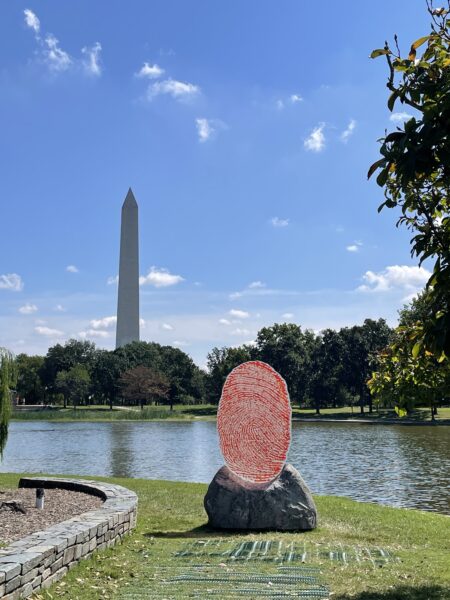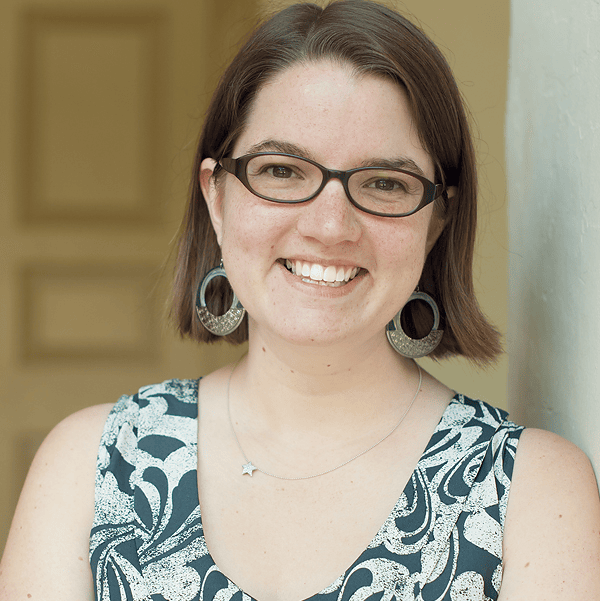
Laura Ansley
When Beyond Granite: Pulling Together arrived for just a month this summer on the National Mall, I was determined to see it. Curated by the Monument Lab’s Paul Farber and Salamishah Tillet, the exhibition included six projects by artists of color responding to the question “What stories remain untold on the National Mall?”
On Wednesday, September 13, the oppressive heat of summer had not yet left DC, but seven AHA staff members nonetheless took the Metro to the Smithsonian / National Mall station. As we came up the escalators, we could hear the bells ringing from the closest installation. Paul Ramírez Jonas’s Let Freedom Ring, an interactive bell tower, was surrounded by children waiting their turn to ring a bell in place of the final note of “My Country ’Tis of Thee.” The children were excited to play their part in completing this song, which has had such significance in the mall’s historic events, from Marian Anderson’s notable 1939 performance of it to its incorporation in Martin Luther King Jr.’s 1963 “I Have a Dream” speech.
As we followed the mall’s gravel pathways west, we encountered five more installations that were striking in different ways. Next to the Washington Monument, we experienced Ashon T. Crawley’s audiovisual Homegoing, a low blue structure that played a three-movement composition invoking Black religious observance and honoring those lost to the AIDS epidemic. Across 17th Street, America’s Playground: DC highlighted the end of school (and playground) segregation in DC; artist Derrick Adams centered a photograph taken in a formerly whites-only park only days after school segregation ended by court ruling. On one side, photograph and playground equipment were in muted black and white; on the other, both burst with bright colors.
The exhibition route took us to an area of the mall I’d never visited before. Rather than walking past the World War II Memorial, along the reflecting pool, until you reach the Lincoln Memorial—the straight path—we headed north through Constitution Gardens until we reached Signers’ Island, which honors the 56 white men who signed the Declaration of Independence. There, with the Washington Monument in the distance, Wendy Red Star (Apsáalooke [Crow]) used her own thumbprint as the basis for The Soil You See . . .. In its red whorls are the names of 50 Apsáalooke men who signed treaties with the United States between 1825 and 1880, often using a thumbprint or an X to indicate their agreement. Going off the beaten path to a much quieter part of the mall made this installation even more affecting. With the signers’ names listed nearby and the Washington Monument in the background, Red Star inspired us to contemplate the many others we could consider “Founders” of this nation, if we only expanded our viewpoint beyond the names we know so well.
Two final installations—Tiffany Chung’s For the Living, a world map crisscrossed with the migration routes of Southeast Asians placed near the Vietnam Veterans Memorial (which will be featured in the December American Historical Review’s History Lab ), and vanessa german’s Of Thee We Sing, a depiction of Marian Anderson performing in front of the Lincoln Memorial—pushed us to think of the stories surrounding our national monuments. Chung honored those who fled Vietnam and neighboring nations alongside those Americans who fought in the Vietnam War. Anderson’s arms opened to her audience, and at the statue’s base were historic images of Black audience members at her 1939 concert. Seeing these faces in front of the Lincoln Memorial, where just 24 years later 250,000 people would gather for the March on Washington for Jobs and Freedom, was yet another reminder of how the National Mall belongs to all Americans, not just those carved in stone.
Seeing the Washington Monument or the US Capitol so frequently, it’s easy to take this place where we live for granted. I can’t speak for my colleagues, but I returned to the office that day grateful for this city and all it offers. But it’s also fun to spend a day playing tourist in our own hometown—especially when doing so helps you to see that city and its memorial landscape from a new perspective.
This work is licensed under a Creative Commons Attribution-NonCommercial-NoDerivatives 4.0 International License. Attribution must provide author name, article title, Perspectives on History, date of publication, and a link to this page. This license applies only to the article, not to text or images used here by permission.

